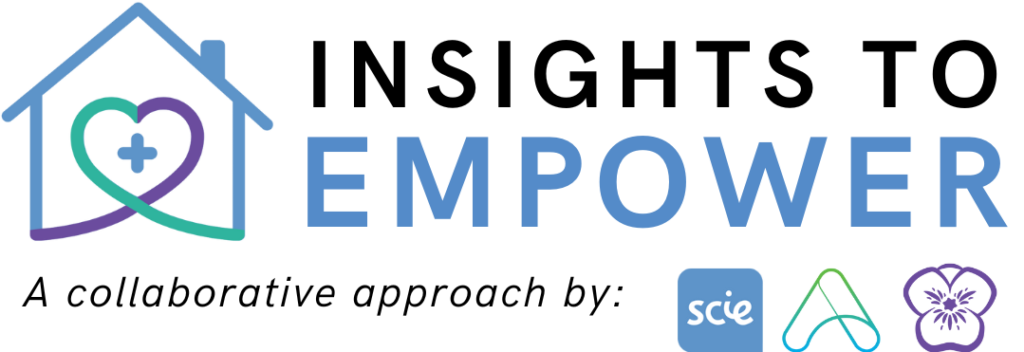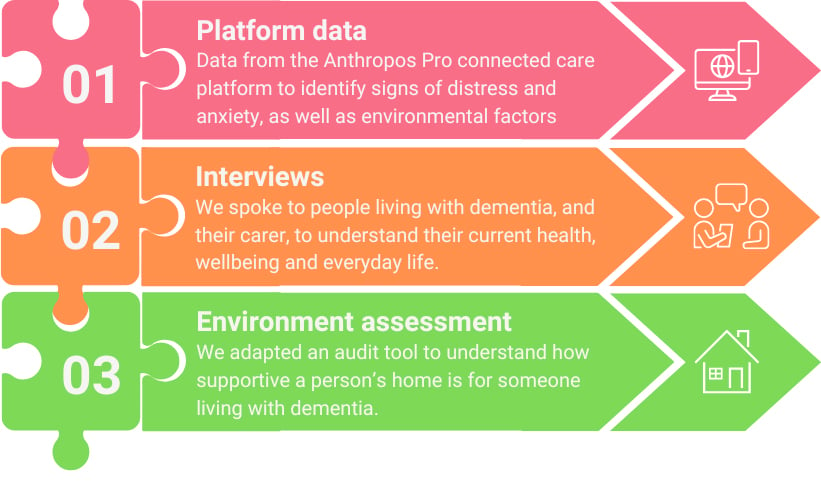Our digital solution that supports people with dementia to remain independent for as long as possible
Published: January 2025

In September 2022, the Alzheimer’s Society, Innovate UK, and Challenge Works launched the Longitude Prize on Dementia, inviting innovators from around the world to create digital solutions that support people with dementia to remain independent for as long as possible. The Social Care Institute for Excellence (SCIE), in collaboration with Anthropos (a technology company) and the Dementia Services Development Centre (DSDC) at the University of Stirling, applied for the challenge.
A total of 175 teams of innovators from around the world applied to take part in the prize and in May 2023, it was announced that our application was successful, and we became one of 24 ‘discovery awardees’, receiving funding to advance our solution to the prototype stage.
‘Insights to Empower’ supports people with dementia living on their own, by spotting signs of distress, anxiety, and disorientation, especially in the evening and nighttime and suggesting interventions to help reduce it. Smart sensors are installed in the home, on doors, shelves and some appliances like the microwave and fridge.
The sensors are discreet and link to a hub, which sends data to the Anthropos care platform. In the first few weeks, the platform learns the person’s usual routine and can then detect changes to that routine over time. Insights to Empower uses this data to identify periods of stress and anxiety. By looking at what is happening in the person’s daily routine and home environment that relates to these periods, we can suggest a helpful intervention for the family or care provider to help reduce that distress. We believe this solution can:
Our project benefits from a unique partnership involving:
Our project was inspired by our shared commitment to improving the lives of people living with dementia. While up to 30% of people living with dementia experience periods of distress, anxiety and disorientation in the evening and at night, there was not enough research into this, particularly for those living alone. We wanted to better understand these periods of distress, learn how we could detect them, and then identify helpful interventions to try to reduce them.
With our team’s expertise and personal connections to dementia, we saw an opportunity to contribute meaningful solutions. By combining research, technology, and care practices, we aimed to promote independence, provide timely care, and support individuals as well as care staff and family carers. Our goal was to improve quality of life by developing a holistic, unobtrusive, and person-centred approach to managing distress, anxiety, and disorientation in dementia.
“Ultimately, our research extends beyond an academic pursuit; it’s an endeavour grounded in personal experiences and a genuine desire to make a positive impact on the lives of those affected by dementia.”— Matthew Ford, Research Analyst at SCIE

Our research was rooted in a holistic approach that combined cutting-edge technology and the home environment, but centred on people living with dementia and those that support them. We worked with people living with dementia who lived alone and already received some support from a homecare provider. Participants had a family carer in regular contact with them who also agreed to take part in the study. We aimed to create a solution that not only addressed the technical and analytics challenge but was embedded in the lived experiences of people living with dementia, their families and care staff.
Our research framework included three core components:
Platform data: Sensor-driven insights
We collected data from strategically placed sensors around a person’s home to monitor daily activities and environmental conditions. These sensors tracked movements, detected falls, and monitored environmental factors (such as temperature and lighting), while identifying signs of potential distress or anxiety, such as:
This data enabled us to identify potential early signs and patterns that may have otherwise gone unnoticed, and by working with the person, their family and care provider we found out if they related to periods of distress, anxiety and disorientation, or were a change related to something else. Where needed, an intervention could then be recommended.
The sensors were all available as part of the Anthropos Pro Connected Care Platform, and the participants who were living with dementia, their home care provider and family could receive the standard alerts (e.g. potential falls) and insights (e.g. getting up more in the night) as usual. Alongside this standard service, we then analysed the sensor data to better understand periods of anxiety, distress and disorientation.
Interviews: Listening to lived experiences
In addition to sensor data, we spoke with individuals living with dementia and their chosen caregiver (family carer or care worker) to gain deeper insights into their everyday lives. These conversations enabled us to:
By combining the quantitative data from sensors with qualitative insights from these interviews, we gained a fuller picture of the lives and experiences of those living with dementia.
Environmental assessment
We know that the home environment can be an essential component in supporting people living with dementia and reducing both accidents and confusion. We adapted an audit tool developed by the Dementia Service Development Centre (DSDC) to evaluate how supportive a home environment was for a person living with dementia.
This involved:
Our future aim is to link this assessment with the platform data and use this to develop interventions that are attuned to the environmental factors within a person’s own home, enabling more tailored recommendations to be made. Home care staff and families also reported being interested in using such an audit tool to identify simple ways the home environment could be made more supportive.
We undertook a comprehensive review of the literature around periods of distress, anxiety and disorientation in dementia, and more widely, to understand what the key presentations are for someone. We looked at what can exacerbate or trigger such periods and what can help reduce them. This review resulted in several key themes: light, sleep, routine and activity, food and drink, and the wider environment.
We mapped the review findings to the sensors available in the Anthropos Pro Connected Care Platform and the metrics they provide. This enabled to us to start to build a detailed framework as to the data we could gather and what it could potentially tell us, alone or in combination.
Working with a home care provider, we worked with seven people living with dementia across England, to pilot ‘Insights to Empower’. We developed case studies that tell their story, bringing together the sensor data, interviews and what we knew about their home environment. By using the interview data together with the sensor data, we built a picture of their day-to-day life and in some cases, instances of distress, anxiety and disorientation. We analysed large data sets to identify patterns, or deviations from their everyday routines. We presented our findings back to care providers and family carers, who were then able to act on this information and share further insights.
Phase one was a proof-of-concept pilot to understand if and how such sensor data could be used to identify and understand periods of distress, anxiety and disorientation. We were successful in proving that concept with a small group of people. We are now planning to expand the pilot to enable us to gain further insights into such periods and to build up our framework that maps sensor data onto evidence base research about dementia. In doing so we will be able to identify and respond to a wider range of issues with appropriate suggestions for an intervention.
In this first pilot we used the standard set of sensors from the Anthropos Pro Connected Care Platform and there is further work to be done in identifying additional, unobtrusive sensors that would give valuable insights for some individuals, so more tailored packages could be used.
We have tested the environmental assessment and plan to continue working in partnership with DSDC to take the next step of integrating it into home care platforms.
There is further work to be undertaken in understanding the costs of such platforms, not only the ‘kit’ but also the time for training care staff, how often they need to check it, how long that takes etc as well as the benefits.
To get in touch about the project or if you are interested in working with SCIE on the next steps of the project please contact us at info@scie.org.